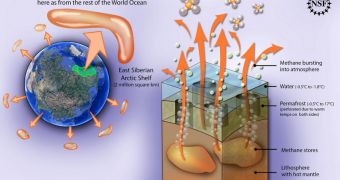According to an international group of experts, it would appear that one of the most important sections of the Arctic Ocean seafloor is becoming unstable. This is extremely dangerous, because this particular location holds vast amounts of the powerful greenhouse gas methane, which it recently began venting out. Methane is several times more toxic to the environment than carbon dioxide is, and so its release must be prevented at all costs, researchers say. The research group was led by experts Natalia Shakhova and Igor Semiletov, who are both based at the University of Alaska Fairbank.
The group also adds that this particular section of permafrost was considered to be one of the impenetrable ones before this study. It is located under the East Siberian Arctic Shelf, and is believed to hold massive amount of methane in its innards. The research revealed that this barrier was in fact perforated, and that large amounts of the greenhouse gas were being released into the atmosphere. Details of the findings appear in the March 5 issue of the top journal Science. The team warns that if even a fraction of the methane here is released, then we could experience a massive surge in global temperatures.
“The amount of methane currently coming out of the East Siberian Arctic Shelf is comparable to the amount coming out of the entire world's oceans. Subsea permafrost is losing its ability to be an impermeable cap,” says Natalia Shakhova, who is also an investigator at the university's International Arctic Research Center. “Our concern is that the subsea permafrost has been showing signs of destabilization already. If it further destabilizes, the methane emissions may not be teragrams, it would be significantly larger,” the scientist adds. Researchers say that methane is on average about 30 times more potent than carbon dioxide to promote global warming and climate change.
“This study is a testament to sustained, careful observations and to international cooperation in research. The Arctic is a difficult place to get to and to work in, but it is important that we do so in order to understand its role in global climate and its response and contribution to ongoing environmental change. It is important to understand the size of the reservoir – the amount of trapped methane that potentially could be released – as well as the processes that have kept it 'trapped' and those that control the release. Work like this helps us to understand and document these processes,” says expert Henrietta Edmonds. She is based at the National Science Foundation (NSF), the organization that partially funded the new research.

 14 DAY TRIAL //
14 DAY TRIAL //